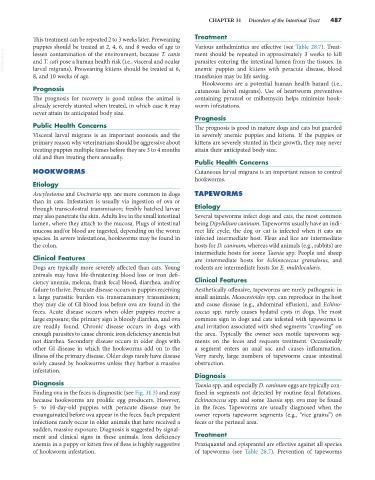Page 515 - Small Animal Internal Medicine, 6th Edition
P. 515
CHAPTER 31 Disorders of the Intestinal Tract 487
This treatment can be repeated 2 to 3 weeks later. Preweaning Treatment
puppies should be treated at 2, 4, 6, and 8 weeks of age to Various anthelmintics are effective (see Table 28.7). Treat-
VetBooks.ir lessen contamination of the environment, because T. canis parasites entering the intestinal lumen from the tissues. In
ment should be repeated in approximately 3 weeks to kill
and T. cati pose a human health risk (i.e., visceral and ocular
anemic puppies and kittens with peracute disease, blood
larval migrans). Preweaning kittens should be treated at 6,
8, and 10 weeks of age. transfusion may be life saving.
Hookworms are a potential human health hazard (i.e.,
Prognosis cutaneous larval migrans). Use of heartworm preventives
The prognosis for recovery is good unless the animal is containing pyrantel or milbemycin helps minimize hook-
already severely stunted when treated, in which case it may worm infestations.
never attain its anticipated body size.
Prognosis
Public Health Concerns The prognosis is good in mature dogs and cats but guarded
Visceral larval migrans is an important zoonosis and the in severely anemic puppies and kittens. If the puppies or
primary reason why veterinarians should be aggressive about kittens are severely stunted in their growth, they may never
treating puppies multiple times before they are 3 to 4 months attain their anticipated body size.
old and then treating them annually.
Public Health Concerns
HOOKWORMS Cutaneous larval migrans is an important reason to control
hookworms.
Etiology
Ancylostoma and Uncinaria spp. are more common in dogs TAPEWORMS
than in cats. Infestation is usually via ingestion of ova or
through transcolostral transmission; freshly hatched larvae Etiology
may also penetrate the skin. Adults live in the small intestinal Several tapeworms infect dogs and cats, the most common
lumen, where they attach to the mucosa. Plugs of intestinal being Dipylidium caninum. Tapeworms usually have an indi-
mucosa and/or blood are ingested, depending on the worm rect life cycle; the dog or cat is infected when it eats an
species. In severe infestations, hookworms may be found in infected intermediate host. Fleas and lice are intermediate
the colon. hosts for D. caninum, whereas wild animals (e.g., rabbits) are
intermediate hosts for some Taenia spp. People and sheep
Clinical Features are intermediate hosts for Echinococcus granulosus, and
Dogs are typically more severely affected than cats. Young rodents are intermediate hosts for E. multilocularis.
animals may have life-threatening blood loss or iron defi-
ciency anemia, melena, frank fecal blood, diarrhea, and/or Clinical Features
failure to thrive. Peracute disease occurs in puppies receiving Aesthetically offensive, tapeworms are rarely pathogenic in
a large parasitic burden via transmammary transmission; small animals. Mesocestoides spp. can reproduce in the host
they may die of GI blood loss before ova are found in the and cause disease (e.g., abdominal effusion), and Echino-
feces. Acute disease occurs when older puppies receive a coccus spp. rarely causes hydatid cysts in dogs. The most
large exposure; the primary sign is bloody diarrhea, and ova common sign in dogs and cats infested with tapeworms is
are readily found. Chronic disease occurs in dogs with anal irritation associated with shed segments “crawling” on
enough parasites to cause chronic iron deficiency anemia but the area. Typically the owner sees motile tapeworm seg-
not diarrhea. Secondary disease occurs in older dogs with ments on the feces and requests treatment. Occasionally
other GI disease in which the hookworms add on to the a segment enters an anal sac and causes inflammation.
illness of the primary disease. Older dogs rarely have disease Very rarely, large numbers of tapeworms cause intestinal
solely caused by hookworms unless they harbor a massive obstruction.
infestation.
Diagnosis
Diagnosis Taenia spp. and especially D. caninum eggs are typically con-
Finding ova in the feces is diagnostic (see Fig. 31.5) and easy fined in segments not detected by routine fecal flotations.
because hookworms are prolific egg producers. However, Echinococcus spp. and some Taenia spp. ova may be found
5- to 10-day-old puppies with peracute disease may be in the feces. Tapeworms are usually diagnosed when the
exsanguinated before ova appear in the feces. Such prepatent owner reports tapeworm segments (e.g., “rice grains”) on
infections rarely occur in older animals that have received a feces or the perineal area.
sudden, massive exposure. Diagnosis is suggested by signal-
ment and clinical signs in these animals. Iron deficiency Treatment
anemia in a puppy or kitten free of fleas is highly suggestive Praziquantel and episprantel are effective against all species
of hookworm infestation. of tapeworms (see Table 28.7). Prevention of tapeworms

